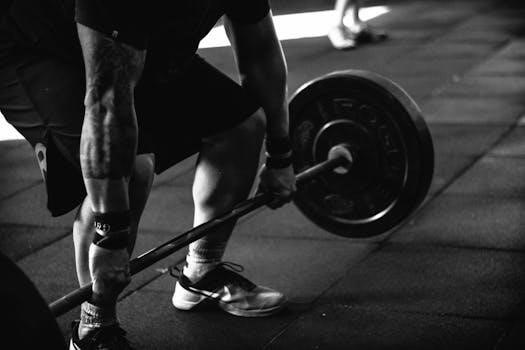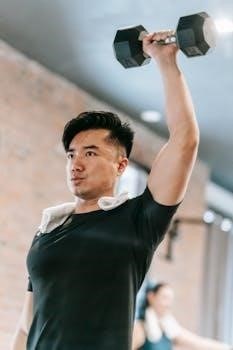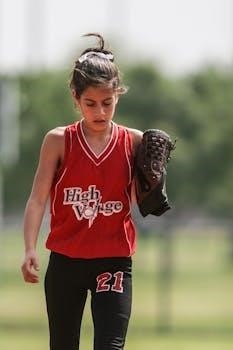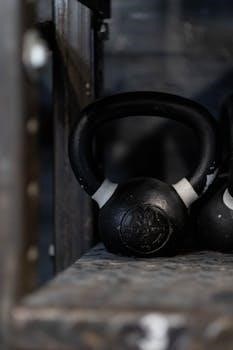Weight training is crucial for softball players, enhancing strength, power, and injury prevention. A well-structured program should incorporate exercises targeting all major muscle groups. It’s vital to focus on proper form and technique to maximize benefits.
Importance of Strength Training for Softball
Strength training is paramount for softball players, enhancing performance and reducing injury risk. It builds muscle, connective tissue, tendons, ligaments, and cartilage, critical for power and stability. Softball-specific exercises improve hitting power, throwing velocity, and running speed. Strength allows players to absorb power and generate force effectively. A balanced program emphasizes glutes and hamstrings, crucial for softball movements. Furthermore, strength training enhances endurance, enabling players to repeat full-speed sprints. It is essential for developing core stability, arm strength, and overall athleticism. Integrating strength workouts ensures improved performance and minimizes the potential for shoulder and elbow injuries. Prioritizing proper training techniques is essential for the best outcomes.
Core Strength Exercises
Core strength is vital for softball players. Exercises like planks, with variations, are essential. A strong core improves stability, power transfer, and overall athletic performance on the field.
Plank Variations for Softball Players
Plank variations are crucial for softball players, enhancing core strength and stability. Incorporate the full plank with arm circles to engage more muscles. Adding walkouts to your plank routine will challenge your core further. Consider the plank lock-off, focusing on maintaining a rigid torso. These variations help with power transfer during hitting and throwing. Remember to maintain proper form to maximize benefits and prevent injuries. Hold each variation for 30 seconds, repeating four times with 30 seconds rest between sets. Consistency and proper technique are key to success in core training.
Lower Body Strength Training
Lower body exercises are essential for softball, focusing on glutes and hamstrings. This builds power for running, hitting, and throwing. Include exercises like lunges and squats in your routine.
Leg Press and Glute Hamstring Raises
The leg press is a powerful exercise for building quadriceps strength, vital for explosive movements in softball. Aim for 15 repetitions to effectively target these muscles. Glute hamstring raises are equally important, strengthening the posterior chain, which includes the glutes and hamstrings. These muscles are crucial for power and stability during running, hitting, and throwing. Focusing on 15 repetitions will help develop the necessary strength. Incorporating these exercises will enhance performance and reduce the risk of injuries. These exercises build the leg strength so important in softball.
Compound Movements for Softball
Compound movements like squats, deadlifts, and lunges are essential for softball players. These exercises engage multiple muscle groups simultaneously, promoting overall strength and power. They mimic the natural movements used in softball, such as running and swinging. These movements contribute to functional strength and improve athletic performance. Integrating these exercises into training programs enhances core stability, leg strength, and upper body power. These movements are key for developing the functional strength needed for softball. The exercises should be performed with proper form to prevent injuries and maximize benefit. Therefore, they are vital for softball athletes.

Upper Body Strength Training
Upper body strength training is vital for softball, focusing on exercises to improve throwing power and bat speed. Rotator cuff work is essential for injury prevention. Building a strong upper body is key.
Rotator Cuff Exercises for Injury Prevention
Rotator cuff exercises are paramount in a softball weight training program for preventing shoulder injuries, which are common in softball. These exercises focus on strengthening the muscles that stabilize the shoulder joint, vital for throwing and swinging. Incorporate light resistance training, using bands or light weights, focusing on external and internal rotations. Include exercises like the “full plank with arm circle” to strengthen the shoulder. Proper form is crucial; avoid heavy weights that can strain the delicate muscles. Consistency with these exercises will enhance shoulder stability, reducing the risk of strains and tears, and improving overall performance.
Training Program Structure
A structured program involves periodization, adjusting training intensity and volume. Training frequency should be considered, with sufficient rest for recovery. It’s important to adjust the program to individual needs.
Training Frequency and Periodization
Training frequency in a softball weight program refers to the number of times an athlete trains per week. This should be carefully planned, considering the athlete’s experience and recovery capabilities. Periodization is the systematic planning of training, varying intensity and volume over time to optimize results. Assessments might include tests for flexibility, speed, power, and strength. A well designed periodization model is crucial for maximizing gains and preventing overtraining. It ensures that athletes are peaking at the right time during the season and allows the body to adapt to the demands of training effectively.

Plyometrics and Agility
Plyometrics are essential for developing power in softball. Agility drills improve quickness and change of direction. These exercises enhance performance, allowing for faster movements on the field.
Incorporating Plyometrics for Power
Plyometric exercises are crucial for developing explosive power in softball players, translating directly to improved hitting, throwing, and running speeds. These exercises, such as jump squats, box jumps, and medicine ball throws, train the muscles to exert maximum force in short intervals. Implementing plyometrics should be done progressively, ensuring proper form to prevent injuries. Start with low-impact variations and gradually increase intensity as strength and technique improve. Plyometric training enhances the stretch-shortening cycle, which is essential for generating power during athletic movements. It is best to incorporate plyometrics 2-3 times per week, allowing for adequate recovery between sessions to maximize results and reduce risk of injury.
Beginner Exercises
For beginners, goblet squats, reverse lunges, and TRX rows are excellent starting points. These exercises build foundational strength and proper movement patterns, crucial for future advanced training. Focus on technique.
Goblet Squat, Reverse Lunge, and TRX Row
The goblet squat is a foundational exercise that enhances lower body strength and core stability, making it perfect for beginners. Holding a dumbbell or kettlebell close to the chest, squat down while maintaining a straight back. Next, the reverse lunge strengthens the legs while improving balance and coordination; step backward, lowering the knee towards the ground. Finally, the TRX row engages the upper back and arms, promoting good posture and pulling strength by leaning back and pulling yourself towards the handles. These exercises are ideal for softball players starting their weight training journey, as they emphasize proper movement and foundational strength.
Off-Season Training Programs
Off-season programs are essential for softball players to build strength and improve fitness. These programs should include a mix of weight training, conditioning, and proper rest for optimal results.
12-Week Off-Season Lifting Program
A 12-week off-season lifting program for softball players should be structured to gradually increase intensity and volume. The program typically begins with foundational strength exercises, progressing to more complex movements. Core strength, lower body power, and upper body strength are prioritized through exercises like barbell squats, Romanian deadlifts, and rotator cuff work. The program should incorporate assessments to determine training loads. It is important to have a balanced approach, ensuring proper rest and recovery. It should be tailored to individual needs, incorporating flexibility and agility training as well.

Circuit Training for Softball
Circuit training is beneficial for softball, combining strength and conditioning. It involves a series of exercises performed with minimal rest. This approach improves endurance and builds overall fitness, enhancing game performance.
Sample Strength Training Circuit
A sample circuit for softball could include exercises like walkouts, push-ups (on knees if needed), full planks with arm circles, and X jumps, performed for 30 seconds each, with 30 seconds of rest in between. Repeat this sequence four times. This format combines strength, core work, and cardio, promoting overall athletic development. This type of circuit is designed to build both strength and endurance simultaneously. These exercises target multiple muscle groups, making it a comprehensive workout. Remember to focus on maintaining proper form during each exercise to maximize benefits and prevent injuries. Consistency is key for effective results.
Injury Prevention
Strengthening shoulder and elbow ligaments is crucial for softball players. Preventing injuries involves proper conditioning and targeted exercises. Consistent training reduces the risk of common softball-related injuries.
Strengthening Shoulder and Elbow Ligaments
Softball players frequently experience shoulder and elbow injuries, making targeted strengthening vital. Incorporating rotator cuff exercises is crucial for injury prevention. These exercises enhance stability and flexibility, protecting ligaments during throwing and swinging motions. Focus on controlled movements and proper form to maximize effectiveness and minimize risk. Regularly performing these exercises will build resilience, reducing the likelihood of strains and sprains. Consistency is key to long-term ligament health, enabling players to perform at their best. Proper strengthening helps maintain joint integrity, which is essential for any athlete. It’s an investment in longevity and performance.

Importance of Recovery and Nutrition
Proper nutrition and recovery are vital for softball players. These elements allow the body to repair and rebuild after intense training. Optimizing these aspects improves performance and prevents injury.
Optimizing Recovery for Softball Players
Softball players must prioritize recovery to maximize their training efforts and prevent injuries. Adequate sleep is crucial, allowing the body to repair muscle tissue and replenish energy stores. Proper nutrition, including sufficient protein intake, supports muscle recovery and growth. Hydration is also key, as it helps transport nutrients and remove waste products. Active recovery, such as light stretching or walking, can reduce muscle stiffness. Furthermore, rest days are essential to avoid overtraining and allow the body to fully recuperate. Failing to prioritize recovery can hinder performance and increase the risk of injury.


